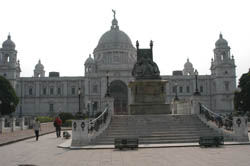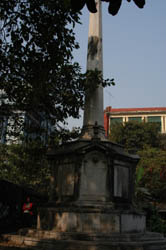Kolkata
(Calcutta)
|
|
|
|
Victoria
Memorial
|
|

|
 Commissioned
by Lord Curzon, the Victorial Memorial was built between 1906 and 1921
and is an impressive white marble building set in immaculately kept
grounds with ornamental pools. It is a very pleasant place just to
stroll around the grounds, away from the bustle in the streets and with
the cover of the trees offering some escape from the heat of the sun. A
bronze statue of Queen Victoria guards the approach. Commissioned
by Lord Curzon, the Victorial Memorial was built between 1906 and 1921
and is an impressive white marble building set in immaculately kept
grounds with ornamental pools. It is a very pleasant place just to
stroll around the grounds, away from the bustle in the streets and with
the cover of the trees offering some escape from the heat of the sun. A
bronze statue of Queen Victoria guards the approach.
During the evening the memorial is illuminated.
Inside it houses a very interesting museum covering the history of
the city and British India in general. We don't particularly like
museums but were impressed with this one. It helped to bring the city
(and India) into focus.
|
 |
|
|
St Paul's Cathedral
|

|
A
Short and pleasant walk away from the Victoria memorial is the original
city church of British India. St Paul's Cathedral was completed in 1847
although the original steeples were destroyed by earthquakes. The
replacement tower was built in 1938.
Although very close to the hustle and bustle, this is another peaceful
place away from the maddening crowds
|
|
|
|
We
stayed at the Hindustan International Hotel which is very close to the
Victoria Memorial. Also nearby (and within easy walking distance) are
the Maiden, Queens Way with open air light & music shows (when we
were there anyway), St Paul's Cathedral and the Planetarium.
|
|
|
| Dalhousie Square (BBD Bagh) |
|

 We
were advised that all pictures of Government buiding were not allowed.
I don't know how true that is but if so it's a shame. Some of the best
buildngs in the city are government buildings, characterised by the
almost trademark red bricks. Writers Building (see left) was
built in 1780 and was the headqurters of the East India Company.
It is now the state Government Secretariat. We
were advised that all pictures of Government buiding were not allowed.
I don't know how true that is but if so it's a shame. Some of the best
buildngs in the city are government buildings, characterised by the
almost trademark red bricks. Writers Building (see left) was
built in 1780 and was the headqurters of the East India Company.
It is now the state Government Secretariat.
Next to Writers building is St Andrew's Church. The church was built in
1818 and is said to be the only air conditioned church in Calcutta.
It's spire and grandeur stands out and stamps it's presence on the
Square.
This area was the heart of British India and numerous other buildings
of interest abound. However, lack of maintenance has meant that many of
these historic building are falling into disrepair.
We were there mainly to get our permits for Sunderbans which is a story
in itself. Close by is St John's church. This was the original
cathedral of the city, and is now mainly famous as the home of the
re-sited monument to the Black hole of Calcutta.
|
|
|
|
Black hole of Calcutta |
|
 |
 This was one of the first things I
had ever heard of Calcutta, and perhaps of the main reasons that
I came. As a boy I
had heard mention of the black hole of Calcutta - however no-one had
explained the story and I took it to mean that Calcutta was a horrible
place to be. This was one of the first things I
had ever heard of Calcutta, and perhaps of the main reasons that
I came. As a boy I
had heard mention of the black hole of Calcutta - however no-one had
explained the story and I took it to mean that Calcutta was a horrible
place to be.
Background
In 1756, the British began strengthening the defences of Fort William.
The Nawab of Bengal, Siraj ud-Daulah, wasn't happy and saw it as a
threat to his countries independence. He ordered a stop to the fort's
military strengthening but was ignored. Siraj then organised his army
& laid siege to the fort, causing many casualties.
Much of the garrison was able to escape, leaving a token force in the
fort under the command of John Holwell, and the fort and Calcutta was
taken.
It is difficult to know what the "truth" is about this story as the
claims made by a surviving officer John Howell seem a bit too far
fetched. It was claimed that 146 people were imprisoned, in a small and
airless dungeon at Fort William. Next morning, when the door was
opened, 123 of the prisoners had died. However, it does seem improbable
that 146 people could have been imprisoned in a room of 24 x 18 feet,
and it seems that at best Holwell greatly exaggerated his story.
However, as it is often said, dont let the truth ruin a good story.
The original memorial laid by Howell disappeared in 1821. The
present day monument was commissioned in 1899 and erected at Dalhousie
Square, believed to be the site of the Black Hole. After numerous
lobbying from Indian leaders the monument was re-sited in the graveyard
of St John's Church in 1940.
|
|
 |
|
|
|
|



